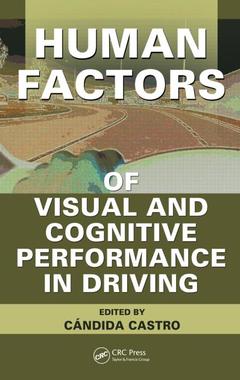Human Factors of Visual and Cognitive Performance in Driving
Auteur : Castro Candida

Human error is involved in more than 90 percent of traffic accidents, and of those accidents, most are associated with visual distractions, or looking-but-failing-to-see errors. Human Factors of Visual and Cognitive Performance in Driving gathers knowledge from a human factors psychology standpoint and provides deeper insight into traffic -user behavior and the ways drivers acquire information from the road.
Emphasizes Drivers as Visual Information Processors
Because driving is an eyes-wide-open task, drivers are exposed to a multitude of visual stimuli along their journey. This information must be correctly processed in order to make the right decisions and perform precise safety maneuvers. With contributions from more than 20 leading experts, this detailed resource discusses road and markings design, new technologies, signage, distraction, safety, situation awareness, workload, driving experience, fatigue, and driving interventions with the goal of improving driving behavior and preventing accidents.
Addresses These Key Areas:
- Visual attention and in-vehicle technologies
- Interventions to reduce road trauma
- Avoiding collisions and the failures involved in that endeavor
Using jargon-free language that is easily understood, this book compresses research from the past few decades into one accessible resource. It clearly and cohesively provides ergonomics and human factor engineers, industrial designers, and highway and roadway engineers with an overarching understanding of the incessant visual demands drivers face.
Visual Demands and Driving. Visual Requirements of Vehicular Guidance. Estimations in Driving. A Two-Dimensional Framework for Understanding the Role of Attentional Selection in Driving. Driver Distractions. Experience and Visual Attention in Driving. The Environment: Roadway Design, Environmental Factors, and Conflicts. On Allocating the Eyes: Visual Attention and In-Vehicle Technologies. Enhancing Safety by Augmenting Information Acquisition in the Driving Environment. Crossmodal Information Processing in Driving. Interventions to Reduce Road Trauma. On Not Getting Hit: The Science of Avoiding Collisions and the Failures Involved in That Endeavor.
Date de parution : 12-2008
15.6x23.4 cm
Date de parution : 09-2019
15.6x23.4 cm
Thèmes de Human Factors of Visual and Cognitive Performance in Driving :
Mots-clés :
Visual Search; Novice Drivers; simulator; OLDER DRIVERS; novice; In-vehicle Device; drivers; Ambient Visual; young; Hazard Perception; search; Young Drivers; national; Experienced Drivers; highway; IVT; traffic; Driving Simulator; safety; Crash Risk; administration; Glance Duration; Information Acquisition Systems; Mental Model; Hazard Perception Test; In-vehicle Task; Fixation Durations; Attentional Selection; Reaction Time; Hazard Perception Training; Cognitive Neuroscience Findings; Public Lighting; Increased Crash Risk; Preview Distance; Left Turn Maneuver



